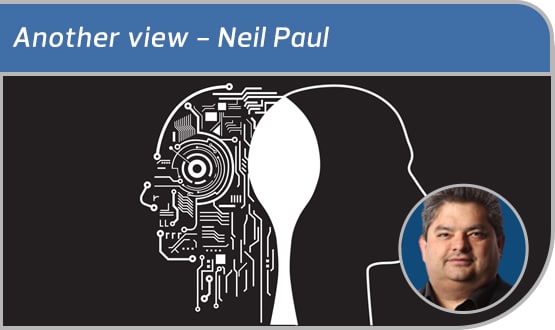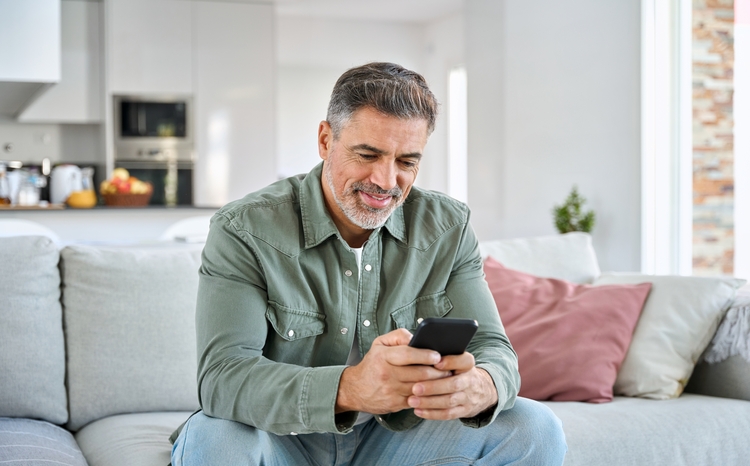An app to put photos into clinical records? Yes, please.
- 26 January 2018

If images taken from smart phones can appear in photo streams in our laptops and PCs, then why isn’t there a more streamlined way of getting photos into electronic health records. Dr Neil Paul explores how it can lead to productivity gains and save money.
My GP federation has developed a dermatology app for our GP clinicians.
It allows any GP to take a photo of a mole or skin rash from any smartphone, type in some information, then ask a question and submit it to a crowdsourced group of consultant dermatologists.
It’s great as you often get a reply in an hour – a pdf with usually helpful advice – and its guaranteed in a day. The original idea was since every clinician carries a smart phone and they all have cameras, why not utilise that than having to buy lots of new kit. It’s a form of BYOD.
You can get a better picture, and therefore better advice, by attaching a dermatoscope attachment. These however cost extra and not everyone wants one or will have it on them all of the time.
You can also access the web portal from a browser and in theory you can use a proper camera with macro lens and flash and tripod (one of my partners is into this!) and upload those photos. To my mind – the text you type and question you ask is often more important.
Images into clinical systems
The problem is we have had to separate the project from our clinical system. The results come back come as a pdf and we can upload these to the record. However, it would be nice if when we took the original image, it was saved with the record and even better if some of the clinical history was automatically attached to the advice request, but suddenly you are then into the realms of becoming an application programming interface (API) partner.
No doubt people will bleat on about information governance issues, but then it will become very slow and very expensive; and my understanding is if you use TPP, then almost impossible. While we think the app is great, the idea wasn’t to refer everything for advice – only those things that you needed help with.
For condition such as moles and rashes, it would be really useful to see what it looked like previously, especially if the previous presentation had been to a different clinician.
We need a clever way of getting images into the record. I can take a photo on my phone anywhere in the world (with signal) and it will appear in my photo stream folder on my home computer without me having to do anything.
Whereas at work, I have to take a photo, email it to myself, open the email, download the image to the desktop, upload it into the record. It’s so long winded.
Productivity gains
The possibilities are huge. My nurse treatment room spends a huge amount of its time dealing with wounds. While we try to preserve continuity of care, it’s not always possible to see the same nurse, particularly if your wound needs dressing every day.
Even though the nurses will type a description of the wound and what they have done but is it the same as seeing it? Wouldn’t it be much better if every time the wound was looked at, it was photographed and recorded in the record?
What if we could link clinical systems to a single cloud-based database of images? So images aren’t stored more than once and all users can get to them? We have audited patients and know that in some cases where the wound wasn’t healing, we have delayed referring on to TV because no one person is really getting a picture of how it’s doing over time.
I believe we could improve wound healing time, reduce prescriptions and save cost if this was routinely available.
There are other possibilities for productivity gains. It’s not just GPs who refer patients. District and practice nurses often ask either senior colleagues, tissue viability staff or even doctors for help.
For instance, there might be a visit request to see Ethel who the district nurse (DN) thinks might need antibiotics. Home visits often take 30 minutes when you could be seeing 3-5 other patients. How much easier would it be if the request came in with a photo and you could prescribe from it?
Or you could get really clever: rather than 50 DNs trying to get hold of 50 GPs who are on call that day, why not have one person (nurse or doctor) available for advice who is able to look at the images.
Scaling up
This is where I start to get excited about the possibilities of working at scale. We have often heard about the need to change the way we work. Move work from secondary care to primary care but apart from some in-reach or out-reach services, have we fundamentally seen a difference?
The trick is to get the work balance right. If you employed a consultant dermatologist full time, you can’t just put them by a phone or Skype and hope enough GPs will ring them to keep them busy all day. Load balancing will be key. It’s also likely you would need more than one to cover holiday and provide a robust service. They need something to do that they can be interrupted from and then take up again.
We use an ECG service from Technomed, where you can upload an ECG and get a report usually next day. However, as they have a room full of technicians reporting all day long you can ring up and request an instant report if you need one. So why not with wound care or dermatology?
Big Brother is watching you
A couple of years ago I was introduced to the idea of Big Brother, which has been increasingly growing on me particularly as we now have much more shared records.
It’s much easier than it ever was to sit in a centralised service and see any patient’s records without multiple logins and passwords.
The concept of Big Brother is that your specialist would monitor all activity not just the ones asking for advice. So back to the treatment room: every day hundreds of wounds are being dressed across an area. In some cases, the nurse will ask for help.
However, let’s imagine that our team could randomly access any patient’s notes who was treated today and see what the wound looked like, what action had been taken and could go back and see how things were progressing.
Now you would hope in most cases the right thing was being done but nurses vary (and the same applies to GPs with dermatology) in their knowledge, experience and prejudices. There is evidence that such an approach might improve adherence to formulary and reduce time to heal.
It might also help standardise care and perhaps allow lower level nurses to deal with problems without having to call in support.
However, it would have to be done in a supportive positive way: Big Brother can be scary and I’ve no idea of the numbers. Perhaps you would think about how to select which cases to review and some AI might help here – pointing out cases where the treatment doesn’t match the diagnosis or some other factors.
But could this revolutionise care of wounds and dermatology?
Less waste? Faster healing times? Less admissions? Less referrals? And all we need is a way of taking photos – getting them into the EPR and then some way of seeing what’s been done today.





16 Comments
The biggest challenge I see in this is ensuring that you have the right image attached to the right patient. If this is a manual data entry process I think you are doomed. If you can crack this in a consistent and reliable way, then you’re on to a winner.
My initial thought would be print out a piece of paper with a code on it and a ruler. Hold it against lesion/rash – give you size scale colour balance and the ID?
We have already cracked the calibration problem (giving you a measurable colour corrected image from any smartphone) in an SBRI challenge and with any luck it will be heading your way soon!
cool. to be honest. im pleased the getting an image in the record bit of this article has attracted interest but the revolutionary bit for me was the big brother oversight idea
Isn’t this what Dicom and IHE xds does? One gives standards for marking up images and the other standards for metadata plus methods for sharing image/document repositories.
My own view is this should have been part of paperless 2020. At least agreeing some commonality to enable sharing in the future.
Gr8 idea, but need to allocate the pic to the appropriate person pathway or stick it on the (nhs?) health time line. Also, could flag the pic to be part o the SCR or not. Wotever, gr8 idea, sounds like it’s been done and NOW needs to be done @ a national level, ’cause person pathways cross different care settings (just who is strong enough to accept the challenge?)
HI Neil,
yes, that would fix the ID onto the image, but the image file would need some meta data to be able to be incorporated into any patient record/ archive (or be searchable!)
Taking pictures is easy, creating data bases is easy (for some) – making them work together is a bit of an art form…
surely it reads the image? ie if the time date and nhs number were on the card in say a QR code. as the image was uploaded the metadata could be extracted from the image. i may be misunderstanding the problem
I think this is a positive way forward but my experience of the principle system suppliers is they are a few steps behind making this kind of idea work as I think we’d all like it too.
Would this just be for clinicians or could/would you extend it out to patients? I think patients would concern a lot of practices especially if there isn’t a review process before being accepted onto the clinical record. Just for clinicians makes sense but any service is going to need a way to match patients up (nhs number most effective) to ensure data is going to the right place.
Look forward to hearing this progress!
Bit more info on how we do this. We embed the NHS number onto the image as an an extra area, black background, white text. We also include it, plus other details, in the metadata. Those details either come from manual entry or, preferably, scanning the 2D barcode on the patient wristband. The mobile app does a quick check against our PAS, confirming patient forename and surname for positive ID.
Currently the images are stored on a local SQL server together with further contextual information (and full audit logs). We investigated storing in PACS but our current supplier did not have a friendly way of injecting images without a) wrapping them in dicom and b) creating an associated CRIS entry. If this changes, we will revisit storing images in PACS.
If we extended the solution to GPs in our area I would envisage only permitting uploads with a valid NHS number. We would make a similar check against our PAS or the SPINE.
Neil – happy to discuss further. We’re based in Plymouth, Devon. We’re probably not ready to support it in the wider NHS but we’re exploring making our work open source through the Apperta Foundation.
At Plymouth Hospitals our team have developed a clinical photography app that can be used on personal smartphones (via BYOD) to take images and send securely to our patient record. These can be accessed through a web portal. No image is stored on the device. You can take and send multiple photos, adding a description to each. We also capture consent details. Users can either manually enter patient identifiers or use the built-in camera to scan the patient wristband. If used on Trust iPods, the barcode sled speeds this process up.
Staff can also view images for a given patient through the same process.
If we exposed the endpoint securely on N3, we could extend this functionality to GPs with further work (mostly around patient lookup, which is currently done with either the hospital or NHS number).
Our pilot team (tissue viability) took over 3000 images for over 500 unique patients last year.
hi – id be interested in discussing this further – always keen to help develop/beta test new software. have access to 100 local practices that might be interested!
I’ve never used dicom and have been hesitant. Yes wether it’s an photo, image or pdf, it will have metadata associated with it (patient details, nhs number, type, etc).
As a contractor it’s great I can essentially solve the same problem for hundreds of systems (money for old rope?). I’d rather move to the next level and start sharing these documents (between clinicians) in simple easy to use manner. IHE, Dicom, openehr, fhir – just pick one and stick to it?
Thanks for that Jason, That’s an interesting approach. manual data entry will always be a weak point and of course patients in primary care don’t usually have wristbands. I would urge caution about using bespoke/ non standards based methods to attach demographics to images. I have, in the past been a fierce critic of DIcom (anyone remember Dicom 2.9?) but it does what it needs to do and does work for the most part. Whist I accept it can appear to be painful creating DB/ RIS entries, you will reap the benefits down the line when all the pieces of a patients record come together (whether through portal/ integration/ open her etc)- something we should all be working towards.
Great article. This is what the nhs needs.
Could this constraint/process be security/privacy related? Protected Health Information (PHI) is key to confidentiality.
Comments are closed.